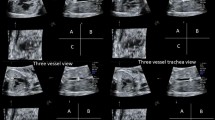Abstract
Purpose
This study aimed to evaluate the accuracy of prenatal diagnosis using a spatio-temporal image correlation-based telediagnosis system at a tertiary referral unit in a Japanese prefecture over a 9-year period, and to investigate the validity of delivery hospital selection.
Methods
This study retrospectively analyzed telediagnosis cases from 2009 to 2018 in six geographically remote hospitals. We built a telediagnosis system called the Kyoto Fetal Ultrasonographic Telediagnosis System (K-FUTS). Three-dimensional ultrasonographic images from these referral hospitals were forwarded to the Kyoto Prefectural University of Medicine (KPUM) Hospital through an optical fiber network system for analysis. The primary endpoint was accuracy of prenatal diagnosis. Cases with severe congenital heart disease (CHD) that required immediate postnatal treatment were identified using the K-FUTS. These cases were then examined to determine whether they were delivered at appropriate hospitals.
Results
During the study period, datasets from 182 cases were transferred to KPUM Hospital. Twenty-one datasets were excluded because of data unavailability or poor image quality. CHD was detected in 14.9% of cases (24/161); the accuracy of prenatal diagnosis was 95.0% (153/161). The K-FUTS identified seven severe cases with CHD requiring immediate postnatal surgical or medical treatment. These cases were delivered at KPUM Hospital with a pediatrician present. The remaining 17 cases considered suitable for delivery at the referral hospitals were delivered there, and they did not require intervention immediately after birth.
Conclusion
Our telediagnosis system contributed to the prenatal diagnosis of CHD and management of pregnancies in patients who were geographically remote from a tertiary hospital.


Similar content being viewed by others
References
Moffett BS, Garrison JM, Hang A, et al. Prostaglandin availability and association with outcomes for infants with congenital heart disease. Pediatr Cardiol. 2016;37:338–44.
Friedberg MK, Silverman NH, Moon-Grady AJ, et al. Prenatal detection of congenital heart disease. J Pediatr. 2009;155:26–31.
Bull C. Current and potential impact of fetal diagnosis on prevalence and spectrum of serious congenital heart disease at term in the UK. Br Paediatr Card Assoc Lancet. 1999;354:1242–7.
Garne E, Loane M, Dolk H, et al. Prenatal diagnosis of severe structural congenital malformations in Europe. Ultrasound Obstet Gynecol. 2005;25:6–11.
McBrien A, Sands A, Craig B, et al. Impact of a regional training program in fetal echocardiography for sonographers on the antenatal detection of major congenital heart disease. Ultrasound Obstet Gynecol. 2010;36:279–84.
Adriaanse BM, Tromp CH, Simpson JM, et al. Interobserver agreement in detailed prenatal diagnosis of congenital heart disease by telemedicine using four-dimensional ultrasound with spatiotemporal image correlation. Ultrasound Obstet Gynecol. 2012;39:203–9.
Donofrio MT, Moon-Grady AJ, Hornberger LK, et al. Diagnosis and treatment of fetal cardiac disease: a scientific statement from the American Heart Association. Circulation. 2014;129:2183–242.
Hishitani T, Fujimoto Y, Saito Y, et al. Accuracy of telediagnosis of fetal heart disease using ultrasound images transmitted via the internet. Pediatr Int. 2014;56:289–91.
Hishitani T, Fujimoto Y, Saito Y, et al. A medical link between local maternity hospitals and a tertiary center using telediagnosis with fetal cardiac ultrasound image transmission. Pediatr Cardiol. 2014;35:652–7.
McCrossan BA, Sands AJ, Kileen T, et al. Fetal diagnosis of congenital heart disease by telemedicine. Arch Dis Child Fetal Neonatal Ed. 2011;96:F394–F397397.
Sharma S, Parness IA, Kamenir SA, et al. Screening fetal echocardiography by telemedicine: efficacy and community acceptance. J Am Soc Echocardiogr. 2003;16:202–8.
McCrossan BA, Sands AJ, Kileen T, et al. A fetal telecardiology service: patient preference and socio-economic factors. Prenat Diagn. 2012;32:883–7.
DeVore GR, Falkensammer P, Sklansky MS, et al. Spatio-temporal image correlation (STIC): new technology for evaluation of the fetal heart. Ultrasound Obstet Gynecol. 2003;22:380–7.
Vinals F. Current experience and prospect of internet consultation in fetal cardiac ultrasound. Fetal Diagn Ther. 2011;30:83–7.
Allan L. Prenatal diagnosis of structural cardiac defects. Am J Med Genet C Semin Med Genet. 2007;145C:73–6.
van Velzzen CL, Clur SA, Rijlaarsdam ME, et al. Prenatal detection of congenital heart disease: results of a national screening programme. BJOG. 2016;123:400–7.
Acknowledgements
We are grateful to Drs. Kuroboshi (North Medical Center KPUM), Noguchi (Maizuru Medical Center), Ogino (Ayabe City Hospital), Okuda (Fukuchiyama City Hospital), Kawamata (Tanabe Central Hospital), and Kitaoka (Kyoto Yamashiro General Medical Center).
Author information
Authors and Affiliations
Corresponding author
Ethics declarations
Conflict of interest
Aki Mabuchi, Miyoko Waratani, Yukiko Tanaka, Taisuke Mori, and Jo Kitawaki declare that they have no conflicts of interest.
Human and animal rights
All procedures followed the ethical standards of the responsible committee on human experimentation (institutional and national) and ethical principles of the Helsinki Declaration of 1964 and later versions.
Informed consent
Informed consent was obtained from all patients for being included in the study.
Additional information
Publisher's Note
Springer Nature remains neutral with regard to jurisdictional claims in published maps and institutional affiliations.
About this article
Cite this article
Mabuchi, A., Waratani, M., Tanaka, Y. et al. Telediagnosis system for congenital heart disease in a Japanese prefecture. J Med Ultrasonics 47, 463–468 (2020). https://doi.org/10.1007/s10396-020-01020-y
Received:
Accepted:
Published:
Issue Date:
DOI: https://doi.org/10.1007/s10396-020-01020-y




